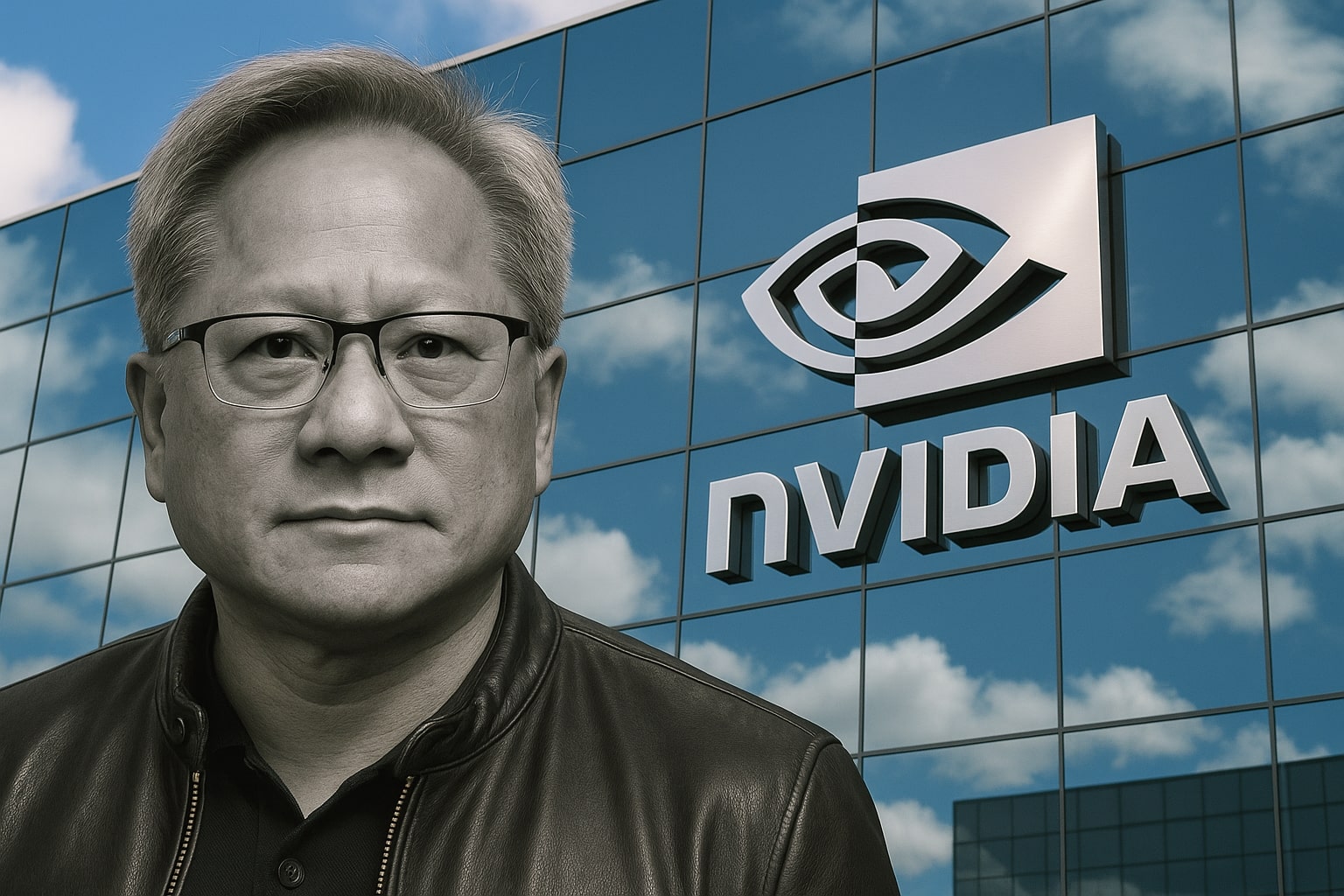
NVIDIA Stock Price Forecast - NVDA Shares Posts $57B Quarter as AI Boom Fuels $500B in Future Orders
AI data centers power 62.5% YoY revenue surge; Q4 guidance hits $65B as Blackwell and Rubin architectures anchor NVIDIA’s growth into 2026 | That's TradingNEWS
NVIDIA (NASDAQ:NVDA) — Record $57B Quarter Confirms AI Dominance, $500B Orders Secure Growth Into 2026
Data Center Expansion Drives Unprecedented Scale
NVIDIA Corporation (NASDAQ:NVDA) delivered a monumental performance in Q3 FY26, reporting $57 billion in revenue, a 62.5% year-on-year surge and $10 billion sequential increase, its strongest quarterly jump on record. Data-center revenue surged to $51.2 billion, up 66.5% y/y and 24.6% q/q, representing nearly 90% of total sales. The growth was powered by the ramp-up of Blackwell GB300 GPUs and next-generation NVLink networking systems, while compute sales jumped 66% as hyperscalers continued aggressive AI buildouts.
Gaming revenue was flat sequentially at $4.27 billion (+30% y/y), professional visualization rose 26.4% q/q to $760 million, and automotive grew 31.8% y/y to $592 million. The weaker segment was OEM and other, steady at $174 million. GAAP gross margin stood at 73.4%, down modestly from 74.6% due to elevated component costs in high-bandwidth memory (HBM) and CoWoS packaging capacity. Despite those constraints, net margin remained near 56%, generating more than $22 billion in free cash flow and supporting $12.5 billion in Q3 share repurchases, with $60 billion still authorized.
Blackwell and Rubin Architectures Define Multi-Year Demand
Management confirmed more than $500 billion in combined Blackwell and Rubin GPU orders stretching into the end of 2026, reflecting unmatched visibility across hyperscaler, enterprise, and sovereign AI programs. The B300 already accounts for two-thirds of Blackwell sales, replacing Hopper’s architecture in most major cloud data centers. The next-generation Rubin platform, scheduled for H2 2026, is expected to exceed the Blackwell’s performance envelope by roughly 2×, supporting long-term compute intensity per gigawatt above $30 billion.
These orders align with projected global AI data-center capacity growth from 49 GW in 2024 to 141 GW by 2030, underscoring a sustained infrastructure cycle rather than a bubble. Microsoft, Amazon, and Alphabet collectively hold AI-buildout backlogs above $600 billion, ensuring persistent demand for NVIDIA GPUs well beyond 2026.
Geopolitical Impact and China Exposure
Sales to China totaled only $50 million in Q3, down from 23% of total revenue a year earlier to 5% now, reflecting U.S. export restrictions and Beijing’s directive for hyperscalers to source locally from Huawei. The H20 custom chip for China contributed negligible revenue, while the blocked B30A GPU curtailed expected shipments. Yet the company’s guidance for Q4 FY26 at $65 billion ( +17% q/q ) excludes any contribution from China, proving that growth momentum remains intact.
Washington is reportedly reconsidering export clearance for H200 GPUs, which could double the performance of throttled H20 models. If approved, it could reopen a $17 billion annual sales channel. CFO Colette Kress confirmed NVIDIA remains “committed to engagement with both governments” to secure balanced trade access.
AI Bubble Debate and Cross-Financing Risks
CEO Jensen Huang directly addressed the “AI bubble” narrative during the earnings call, asserting that real monetization is accelerating. Meta’s GEM foundation model improved ad conversions by 5% on Instagram and 3% on Facebook Feed, quantifying AI-driven ROI at scale.
Investor concerns around ecosystem “cross-financing”—where hyperscalers, chip developers, and AI startups invest in each other—were tempered by Huang’s remarks that each industry and country will fund its own AI infrastructure. NVIDIA itself does not need to finance client expansion, insulating its balance sheet from circular capital risks.
Financial Strength and Upgraded Outlook
Analysts have lifted EBITDA forecasts for NVIDIA by 9.4% for 2025, 24.8% for 2027, and 28.9% for 2028, translating into an annualized 45% CAGR versus 33% previously. Free-cash-flow estimates rose 12.2%, reaching $150 billion+ cumulative through 2028, even after heavy R&D and repurchase programs. EBITDA margins should stabilize around 65%, while free-cash-flow conversion improves as CapEx moderates relative to cash generation.
NVIDIA ended the quarter with a $4.35 trillion market cap, forward P/E 38.2×, PEG 0.74, and short interest 0.98%. The balance sheet shows a net-cash position with minimal debt, maintaining flexibility for continued buybacks.
Inventory and Supply Commitments
Inventory days on hand rose to 130 (+19 days sequentially) as the company stockpiled raw materials and work-in-process units ahead of Rubin’s ramp. Supply commitments climbed 63% q/q, reflecting proactive risk management of HBM and CoWoS bottlenecks. Despite the build, working-capital absorption has not pressured liquidity, and management expects positive operating cash flow each quarter.
Hyperscaler and Enterprise Partnerships Extend Ecosystem Reach
Beyond hyperscalers, NVIDIA expanded into enterprise AI via a new partnership with Palantir Technologies (PLTR) to integrate the CUDA-X stack and Nemotron model suite within Palantir’s AIP platform. The collaboration aims to accelerate enterprise inference workloads using Blackwell architecture, effectively embedding NVIDIA in government and defense-grade AI systems.
Policy Landscape: GAIN AI Act and Domestic Prioritization
The proposed GAIN AI Act in Congress prioritizes U.S. compute capacity over exports. If enacted, it would restrict sales of H-series GPUs abroad until domestic demand is met. While that curtails short-term international sales, it strengthens domestic backlog, with the White House expected to allocate $50 billion for federal AI infrastructure under new public-private initiatives.
Treasury Secretary Scott Bessent noted potential exceptions allowing legacy Blackwell units into China once Rubin becomes the U.S. strategic baseline, effectively keeping NVIDIA’s innovation cadence ahead of export controls.
Valuation Context vs. Peers
At 38× forward P/E, NVIDIA trades below AMD (56×) and slightly above Broadcom (38×), yet its earnings growth outpaces both. On a forward price-to-sales multiple of 23.4×, NVDA is below its five-year average of 26.6×, offering relative value. Support levels stand at $179.80 and $169.03 (100- and 200-day EMAs), with potential downside to $150 if macro risk escalates.
Upside resistance lies at $195–$200, where prior post-earnings rallies stalled. A breakout above $205 could trigger momentum buying toward $241, the newly raised base-case target representing 35% upside.
Q4 FY26 Guidance and Forward Catalysts
For Q4 FY26, NVIDIA guided for $65 billion (±2%) revenue, implying 17% sequential growth, and GAAP gross margin 74.8%. That guidance assumes no China data-center revenue, underscoring internal demand strength. Management expects another round of product launches in autonomous systems and enterprise AI servers early 2026, expanding addressable markets beyond GPUs into full-stack AI infrastructure.With hyperscaler backlog exceeding $1 trillion and government AI funding accelerating, NVIDIA’s near-term earnings visibility is unmatched across mega-cap tech.
Read More
-
Baidu Stock Price Forecast - BIDU Shares Rallies 7% to $118.93 as J.P. Morgan Targets $188
24.11.2025 · TradingNEWS ArchiveStocks
-
XRP Price Forecast - XRP-USD Steadies Above $2.00 as XRP ETF Inflows Surge and Binance Liquidity Shrinks
24.11.2025 · TradingNEWS ArchiveCrypto
-
Oil Price Forecast - Oil Prices Steady at $58 WTI, $63 Brent as Peace Talks and Fed Rate Bets Battle Oversupply
24.11.2025 · TradingNEWS ArchiveCommodities
-
Stock Market Today - Nasdaq Jumps 2.07% as Alphabet and Tesla Spark AI Revival — Fed Cut Odds Top 75%
24.11.2025 · TradingNEWS ArchiveMarkets
-
GBP/USD Price Forecast - Pound Steadies at 1.3088 as UK Budget Looms and BoE Cut Bets Rise to 70%
24.11.2025 · TradingNEWS ArchiveForex
Technical Structure and Market Dynamics
After rebounding +1.95% to $182.37, NVDA trades within a $173–$195 range. MACD momentum has normalized after a –2 SD bounce, and RSI (45) shows neutral conditions. Support zones at $179–$169 represent high-volume accumulation areas. Should broader risk sentiment stabilize, institutional re-entries could lift shares back toward $200–$205 in Q1 2026.
Strategic Assessment
Even under conservative assumptions—no China sales, normalization of gross margin to 73%, and modest CapEx growth—NVIDIA is positioned for 45%+ EBITDA CAGR (2025–2028) and robust free-cash-flow expansion. Every major AI cycle indicator—from hyperscaler backlog to enterprise adoption—points to sustained multi-year demand.
Verdict: Strong Buy
Based on growth durability, superior profitability, and unmatched order visibility, NVIDIA (NASDAQ: NVDA) remains a Strong Buy, with a fair-value range of $240–$260 and bull-case scenario near $404 by 2026. The stock trades at a discount to its historical growth multiple, the AI buildout cycle remains early, and internal liquidity ensures stability through volatility.



















